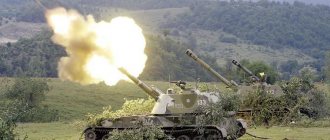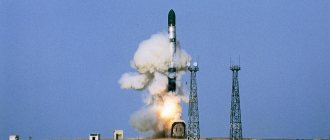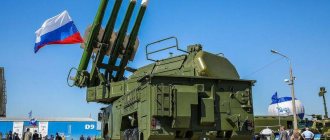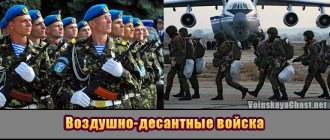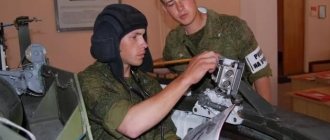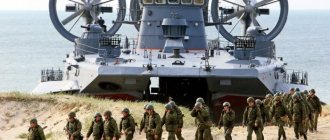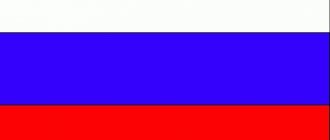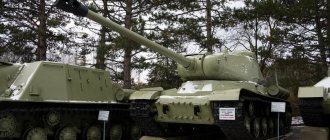Main tasks of missile forces and artillery
Missile Forces and Artillery (RF&A) is a branch of the Ground Forces, which is the main means of fire and nuclear destruction of the enemy during combined arms operations (combat operations).
They are designed to perform the following main tasks:
- gaining and maintaining fire superiority over the enemy;
- defeat of its nuclear attack means, manpower, weapons, military and special equipment;
- disorganization of systems for command and control of troops and weapons, reconnaissance and electronic warfare;
- destruction of long-term defensive structures and other infrastructure;
- disruption of operational and military logistics;
- weakening and isolating the enemy's second echelons and reserves;
- destruction of enemy tanks and other armored vehicles that have penetrated into the depths of the defense;
- covering open flanks and joints;
- participation in the destruction of enemy air and sea landings;
- remote mining of terrain and objects;
- lighting support for night operations of troops;
- smoke, blinding enemy targets;
- distribution of propaganda materials and others.
Organizationally, RV and A consist of missile, rocket, artillery brigades, including mixed, high-power artillery divisions, rocket artillery regiments, individual reconnaissance divisions, as well as artillery of combined arms brigades and military bases.
Further development and enhancement of the combat capabilities of the Russian Army and Army Air Forces is carried out by creating reconnaissance and fire contours, including on a temporary basis, ensuring the destruction of targets in real time, equipping formations and units of the Russian Army and Army with high-precision weapons, increasing the firing range and power of the weapons used ammunition, as well as automation of the processes of preparation and firing.
History of creation
Humanity began launching rockets immediately after the invention of gunpowder. Even in ancient China, the combat use of this weapon was noticed, however, due to the lack of technical equipment, it was difficult to call it an effective weapon.
In the 18th century, the British Army began using Congreve rockets, which remained in service with Her Majesty's troops for several decades. They lacked accuracy, and therefore, when barreled weapons appeared, missiles were discontinued.
Formation of troops in the USSR
Shortly after the end of World War I, several countries began to develop and experiment with anti-aircraft weapons. Our country succeeded in this matter, and by the time the Great Patriotic War began, the BM-13 installation, known as “Katyusha,” was installed in service.
The first ballistic missiles that were in the RSFSR were the conquered developments of the German inventor. The missiles did not have a long flight range; they served only standard tasks. The first ballistic warhead of the RSFSR ICBM was the R-7, which became the very first ballistic missile of the USSR. It had a range of 8,000 km and was first launched in 1957. Then, with its help, the first space satellite of our planet was launched into orbit.
In the 1960s, emphasis was placed on developing an intercontinental ballistic warhead that would be launched from a launch silo located underground.
At the same time, work is underway on rocket artillery. Thus, in 1963 the BM-21 Grad was introduced, and it is at the disposal of the Russian army to this day.
In the late 1960s, work began on the so-called "flower" series of self-propelled weapons: "Peony", "Nail" and "Acacia". Today they are used in the weapons of the Russian army.
At the end of the 70s, the Strategic Missile Forces received intercontinental ballistic heads with different combat areas, which significantly increased their combat potential. On December 30, 1975, the R-36M, most famously named “Satan”, was put into operation, which was recognized as a more highly effective assault weapon of the strategic forces of the USSR and later the Russian Federation.
In the same year, the Tochka rocket launcher appeared.
In 1987 he was accepted into the Smerch MLRS. By the way, he was recognized as the most effective weapon of that time and held this post for several years.
Troops in our time
After the Soviet Union collapsed, most of Russia's military capabilities became proprietary. ICBMs were quickly withdrawn to Russian territory, and the mines remaining in other CIS countries were liquidated (1996). The Russian Union of Industrialists and Entrepreneurs of Russia received the first stationary Topol-M installation, which is an ICBM of five generations. In Russia, despite economic difficulties, the missile forces are being rearmed.
ICBMs that have lost their relevance will be replaced by the latest Topol-M and Yars, work is underway on a liquid-propellant missile system, which has been given the name “Sarmat”. In the 2010s, the Russian Federation and the USSR entered into an agreement to regulate the number of warheads and their translators. OSV-3.
The documents say that each country has the right to weapons of no less than 1,550 nuclear weapons and only 770 delivery vehicles. These include ICBMs, strategic aircraft, and missile submarines.
The treaty also provides for a ban on the production of missiles that separate military units, but this does not mean that states cannot develop new technologies in this area.
Military uniform of the Soviet Red Army 1941-1943 photo
Let's talk about the Military uniform of the Soviet Red Army 1941-1943 photo , undeservedly forgotten and unappreciated, the military uniform of our grandfathers in which they kicked the Wehrmacht's ass. Start here. And with the military uniform of the Germans, everything is also not entirely smooth, although after watching our Russian films: in a jacket, in boots and with a machine gun at the ready. But in reality: with a carbine, in a tunic (tunic varies from tunic to tunic), and not always in boots, even very often in boots. In winter?... As luck would have it, problems with winter uniforms plagued the Wehrmacht until the end of the war (they were never resolved). In the second half of the war, the quality of materials deteriorated so rapidly that... “we’re just not used to going into detail”, the introduction of an additional button was required!!! Do you know why? The quality of the materials became such that the German jacket began to resemble a loose shirt, and so another button was introduced to hold this shapeless uniform. And the design was constantly shifting towards simplification. The uniforms converted to German standards were widely used: English, French, Polish uniforms, etc. it was like that.
- Described in detail here: >> Military uniform of Wehrmacht soldiers Eastern Front.
- Here: >> German military uniform of the Second World War.
- Here: >> Military uniform of the Soviet Red Army .
Red Army military equipment photo
equipment description
| 1.Officer's belt model 1932 and 1943 |
| 2. Officer's belt, model 1935. |
| 3.Soldier's leather belt |
| 4. Belt of junior command staff |
| 5.Soldier's canvas belt |
| 6. Helmet model 1916 |
| 7. Helmet model l936g. |
| 8. Civil defense helmet l938g |
| 9. Helmet sample 40 gg M 1940 |
| 10. glasses |
| 11. types of commander tablets |
On February 1, the People's Commissar of Defense ordered No. 005, which provided for the unification of uniforms and its adaptation to wartime conditions. The February 1941 order was classified “top secret”. This means that the USSR did not know about the impending invasion, it knew and was actively preparing. Changes and innovations were carried out based on the experience gained from the Winter War with Finland in 1939-40, which gave impetus to a number of changes Military uniform of the Soviet Red Army 1941-1943 photo . Of the entire order, the following were made public: the transition to a single color of uniforms, the introduction of new, more popular and widespread fabrics, and the gradual introduction of beautiful ceremonial uniforms in combat units. Supply standards established for peacetime and wartime were not subject to disclosure.
According to these standards, the uniform that was to be accumulated by the beginning of the mobilization deployment of the army consisted of: a khaki cap (in winter - a hat with earflaps, model 1940, until 40, and even in the winter of 41, due to the shortage of hats with earflaps, often soldiers of the Red Army were dressed in a budenovka), tunics with khaki trousers (for ordinary personnel in winter and summer - only cotton tunics) and a single-breasted dark gray overcoat with a hook-and-eye fastener.
Red Army soldier, infantry 1941-43. Red Army Cavalry 1941
For the winter period, in addition, the following items were provided: a short fur coat or a padded jacket with a padded jacket (for the command staff - a fur vest), cotton trousers, fur mittens and felt boots. And based on the adopted norms, detailed regulations on the supply of clothing to the army conducting combat operations were prepared in secret.
motorcyclist motor transport battalion
On June 30, 1941, hastily finalized in connection with Germany's unexpected attack on the USSR, this information was announced by a circular from the chief quartermaster for the information of the entire Red Army. However, at this moment, the first priority was not supplying the front, but rescuing front-line supplies from those areas where the troops were retreating. The beginning of the war turned out to be extremely unfavorable for the Red Army. Large military reserves of food, weapons and clothing located in border military districts fell into the hands of the enemy or were surrounded.
Red Army soldier, infantry 1941-43.
Uniform resources for replenishment turned out to be significantly reduced, and therefore, on July 13, 1941, it was decided to temporarily replace the cap with a cap and the overcoat with a padded jacket or padded jacket for the period of conscript training in reserve units. By the end of the sixth week of the war, the vulnerability of the command staff (primarily command staff) and generals at the front became obvious due to their too noticeable differences.
Commander of the Red Army rifle division 40-41
The division commander's uniform is made from the highest quality materials and tailoring. On the cap, a circular cockade was introduced for generals in 1940. Scarlet stripes, jacket sleeve cuffs with piping, colored buttonholes. Waist belt introduced in 1935, holster for Korovin TK (Tula Korovin) pistol. On the left chest, the “Order of Lenin” was established in 1930 and the medal commemorates the “20th anniversary of the Red Army of workers and peasants” created on January 24, 1938. The outbreak of war found the armed forces in a state of partial reorganization after the Winter War with Finland. Of the 303 divisions of the Red Army, 229 were rifle divisions. The division at the beginning of 1941 consisted of 14 50 troops, three infantry and two artillery regiments, an anti-tank and anti-aircraft division and a battalion of tanks. More than 100 rifle divisions were virtually destroyed in the summer fighting of 1941; all men from 23 to 36 years old were drafted into the army. Of these, 286 new divisions were formed, the strength reduced to approximately 10,900 people.
Sergeant major of the NKVD, border troops, summer uniform 1941
The most organized, trained and equipped, subordinate to the People's Committee of Internal Affairs (NKVD). Not to be confused with the internal troops of the NKVD, which were responsible for internal security, at the start of the war the NKVD troops consisted of 15 rifle and cavalry divisions. The border troops most distinguished themselves in battles at the first stage of the war. A distinctive feature of their uniform was the cap. with a bright green crown and a dark blue band, with red edging. The PPSh-41 submachine gun is available only to selected troops. Spare magazine, in a canvas semicircular bag on the belt. An aluminum flask (although glass was more often used), binoculars, a flashlight and a gas mask.
On August 1, 1941, an order was distributed by telegraph ordering the abolition of the wearing of sleeve insignia for all command personnel located in the theater of military operations and in marching units, the establishment of all branches of the army in the field army wearing khaki buttonholes with protective insignia, and also issue at the front generals have a protective tunic and trousers without stripes. By the end of August 1941, protective buttonholes and insignia were distributed to the fronts.
Naval aviation pilot, 1941-45. Submachine gunner, mountain rifle units, 1942-43.
On August 3, 1941, a new women's uniform was installed (for non-combatant command personnel): khaki beret, dress and coat. The dress was cut in 1937, made of cotton fabric; later a similar dress appeared in woolen fabric. For women holding command positions, the tunic, skirt and overcoat were retained. On August 11, 1941, by secret order, the issuance of new clothing to personnel of the rear units and institutions of the Red Army was stopped. By August 25, all available new uniforms should have been transferred to provide units leaving for the front.
artilleryman, summer 1941
The cap has replaced the Budenovka since the late 1930s, although most officers prefer the traditional cap. The pilot was more convenient in field conditions. Excellent quality officer's tunic, with scarlet piping on the collar and cuffs. The order of August 1, 1941 abolished the chevrons on the sleeves. On August 3, 1941 it was announced that the stars and buttons would be painted olive green (khaki), which were to be painted. In practice, especially given the chaos in the summer and autumn of 1941. this was not always followed. Mauser in its wooden stock/holster, out of place in the photo. But it was a popular weapon among the military. Binoculars model 1931.
Rank and file uniforms of the Red Army 1941
Steel helmet model 1936, with flared edges and a small crest on top. The tunic and trousers are standard, with characteristic diamond-shaped knee pads in the knees of the trousers for more wear resistance. From April 1941, the collar buttonholes should have been muted in military field conditions, khaki color. But old photos show that they were often preserved until the introduction of shoulder straps in 1943. The soldier wears windings - which were of various colors, made from all types of worn-out uniforms - and boots.
Junior sergeant, infantry equipment elements 1941, corps commissar
Several million pairs of boots were supplied to the United States under Lend-Lease to the USSR. He is armed with a Mosin rifle, also known as a three-line rifle, model 1938, leather pouches for ammunition, a canvas bag for two RGD-33 hand grenades and a gas mask. At the beginning of the war, the Red Army had 13 cavalry divisions, although they were significantly reduced due to the commitment to mechanization of the army from the late 1930s. In August 1941, the cavalry division's strength was reduced to 3,000 men—essentially a brigade—but the number of divisions was increased, reaching 82 by the end of 1941.
Cavalryman, Red Army 1941
It is naive to think that the role of cavalry was small, here is an excerpt from Shederovich’s dialogue “and how we met the fur of the Wehrmacht corps, the Dovator’s cavalry,” and he does not know that in the most difficult days of the beginning of the war, only the cavalry could respond mobile to breakthroughs of German wedges, and She threw herself under these wedges, often after a march of 200-500 km, do you think at least one tank formation will be able to march at least 300 km? There was an attempt at the beginning of the war to hit the flank of the German wedge with a tank formation after the march, but 80% of the tanks simply did not arrive.
In the manual of 1933, cavalry were ordered to conduct combat operations dismounted . The heyday of the cavalry was in 1942, during the campaign in the south: although tactically outdated, the cavalry troops made a huge contribution to the local conditions of the front, and fulfilled the role of mobile troops while the Red Army built up tank forces. And it was she who stood in the way of the German troops rushing to the aid of Paulus’s army locked in the Stalingrad cauldron. Although the importance of cavalry declines later in the war, the number of cavalry troops even increased by 1945. And not only with us, but also with the Wehrmacht (the number of cavalry formations has been doubled). Many cavalrymen retained the old style of blue riding breeches and caps until the end of the war. Blue buttonholes and black piping. The royal model saber first appeared in 1881; since 1927, the Cossack model cavalry saber has been produced. Leather belts with a pocket for a whistle, usually for officers. Mosin rifle, also known as a three-line rifle, model 1938.
Scout in summer camouflage and sniper in autumn camouflage
In “ Military uniform of the Soviet Red Army 1941-1943 photo” various types of camouflage were widely used, before writing the article I did not know that camouflage was commercially produced , it was first used and worked well at Khalkin Gol , before the war an autumn version of the brown camouflage appeared spots on a green-ocher background. Here are real photos from the war.
sniper Merkulov is dressed in a little-known example of camouflage clothing - a raincoat with a camouflage pattern
Already during the war, the “autumn leaf” camouflage was developed.
Kpasnaya Army - Scouts in various types of camouflage
types of camouflage
This description of “ Military uniform of the Soviet Red Army 1941-1943 photo” is not over; further trends and development of the military uniform of the Red Army since 1943, the year of introduction of shoulder straps, can be seen here:
- >> Military uniform of the Soviet Red Army since 1943 photo
- >> Military uniform of Wehrmacht soldiers Eastern Front photo
- >> German military uniform of the Second World War photo
- >> Military uniform of the Soviet Red Army photo
Structure, composition and armament of the Strategic Missile Forces
Today, the Strategic Missile Forces includes three armies: the 31st (Orenburg), the 27th Guards (Vladimir) and the 33rd Guards (Omsk), consisting of twelve missile divisions, as well as the Central Command Post and the Main Headquarters of the Missile Forces.
In addition to military units, the Strategic Missile Forces include several training grounds (Kapustin Yar, Sary-Shagan, Kamchatka), two educational institutions (an academy in Balashikha and an institute in Serpukhov), production facilities and bases for storing and repairing equipment.
Currently, the Strategic Missile Forces of the Russian Armed Forces are armed with 305 missile systems of five different types:
- UR-100NUTTKH – 60 (320 warheads);
- R-36M2 (and its modifications) – 46 (460 warheads);
- "Topol" - 72 (72 warheads);
- “Topol-M” (including silo and mobile versions) – 78 (78 warheads);
- "Yars" - 49 (196 warheads).
In total, the above complexes can carry 1166 nuclear warheads.
The central command post (CCP) of the Strategic Missile Forces is located in the village of Vlasikha (Moscow region), it is located in a bunker at a depth of 30 meters. There are four rotating shifts on continuous combat duty. The communications equipment of the Central Command Center allows you to maintain continuous communication with all other posts of the missile forces and military units, receive information from them and respond to it in a timely manner.
Russian strategic nuclear forces use the Kazbek automated combat control system, its portable terminal - the so-called “black suitcase”, which is constantly kept by the President of the Russian Federation; the Minister of Defense and the Chief of the General Staff have similar “suitcases”. Currently, work is underway to modernize the automated control system; the new fifth-generation system will make it possible to quickly retarget ICBMs, as well as communicate orders directly to each launcher.
The Strategic Missile Forces of the Russian Federation are equipped with a unique “Perimeter” system, which in the West was nicknamed “Dead Hand”. It makes it possible to strike back at the aggressor, even if all command and control links of the Strategic Missile Forces are destroyed.
Currently, the Strategic Missile Forces are being rearmed with new Yars missiles with multiple warheads. Tests of a more advanced modification of the Yars, the R-26 Rubezh, have been completed. Work is underway to create a new heavy missile “Sarmat”, which should replace the outdated Soviet “Voevoda”.
The development of the new Barguzin railway missile system continues, but its testing dates are constantly being postponed.
Female military uniform
Separate models were developed for the fair half of our army. The new military uniform pleases not only with its practicality, but also with its aesthetics.
Summer uniform for female military personnel of the Army and Air Force
Casual
The summer casual women's uniform includes khaki or blue caps , jackets, skirts and blouses, a black tie with a gold tack, a khaki belt (for the formation), black shoes or boots . The second version of the uniform involves a khaki or blue cap, suit ( jacket and trousers) , T-shirt and black shoes skirts or trousers , berets , vests ( airborne forces and special forces.
Casual summer uniform (except for officers and warrant officers: camouflage caps , suits , khaki underwear, black socks and combat boots .
Front door
The summer dress uniform for women includes blue caps , jackets and skirts , white blouses, black ties with gold fasteners, a golden belt (for formation, black shoes or boots .
Dress summer uniform (except for officers and warrant officers: protective or blue cap , suit ( jacket and trousers , T-shirt , black shoes or boots .
Winter uniform of female military personnel of the Army and Air Force
Casual
The winter casual women's uniform includes a gray earflap, protective or blue winter jackets , mufflers, jackets, skirts and blouses, a black tie with gold fastening, a khaki belt (for the formation, black boots or shoes , black gloves . The second version of the uniform assumes a gray earflaps, protective or blue suits ( trousers and jacket , T-shirts and mufflers, khaki-colored belt (for formations, black boots or shoes , black gloves ). Senior officers and colonels wear an astrakhan fur hat with a visor. It is allowed to wear a black fur hat with a leather jacket ( only for senior officers out of formation, caps , berets, vests ( airborne forces and special forces, demi-season jackets , trousers , shirts with trousers, skirts .
Casual summer uniform (except for officers and warrant officers: camouflage earflaps, insulated jackets and trousers , demi-season suits , lightweight or fleece underwear, khaki scarf , black socks , boots and gloves . It is allowed to wear earflaps, berets , balaclava, fleece jacket, windbreaker, windproof suit , insulated vest , vest ( airborne and special forces), insulated mittens, khaki belt (for formation.
Front door
Women's winter dress uniform includes gray ear flaps, protective or blue winter jackets , blue jackets and skirts , white blouses, black ties with gold clasps, white mufflers, golden belts (for formations, black boots or boots , black gloves . Senior officers and Colonels wear astrakhan hats berets , vests ( airborne and special forces, a demi-season jacket, white gloves .
Dress summer uniform (except for officers and warrant officers: gray earflaps, protective or blue jacket , suit ( trousers and jacket , T-shirts and mufflers, khaki belt (for formations, black boots or boots , black gloves ).
Summer uniform of female military personnel of the Navy
Casual
Front door
Winter uniform of female military personnel of the Navy
Front door
Casual
Interesting Facts
- Most of the famous Katyushas used during the Great Patriotic War were based on American cargo transport vehicles - Stude Baker. The reason was that the evacuated plants and factories did not have time to produce the required ZIS-6s, which were originally equipped with BMP-13s. From 1942 to 1945 The United States delivered trucks to the USSR under the Lend-Lease program.
- According to Golitsyn’s chronicle, the very first howitzer salvo was heard on the territory of Russia in 1389, during the reign of Prince Dmitry Donskoy, and Russian howitzers, purchased by Russians abroad along with guns, were used for the first time.
